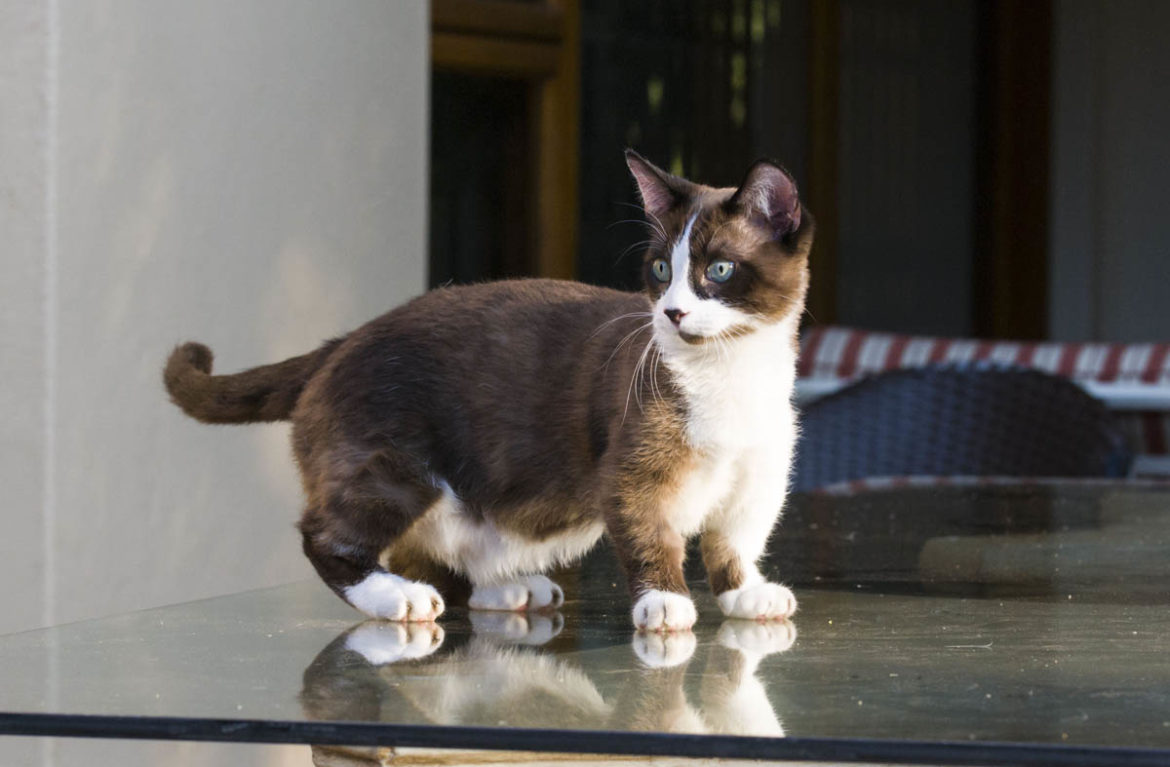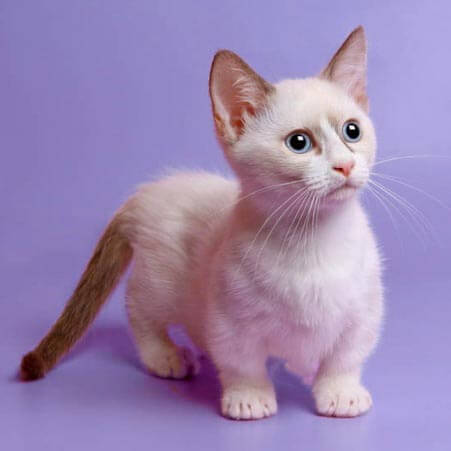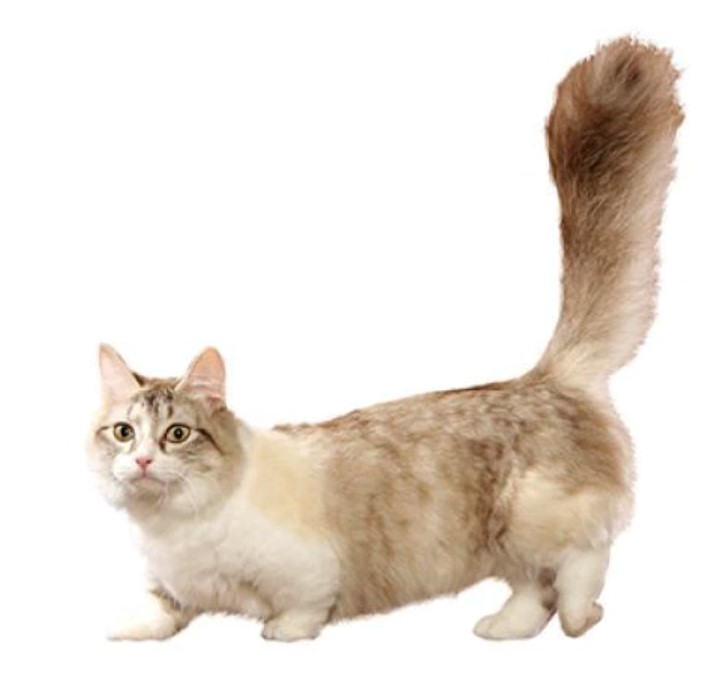This original-looking cat breed from the USA is still a rarity elsewhere. Their characteristic short legs are the result of a spontaneous gene mutation. It is precisely this characteristic in connection with its unmistakable nature that makes the Munchkin cat so special in the eyes of its breeders and fans.
Appearance: The Short-legged Cat

The legs of the Munchkins are striking. These are extremely short in relation to the body. They are the hallmarks of this breed of cats. At the same time, the legs of the Munchkin are strong and muscular.
Their ears are disproportionately large, point upright on the head, and are slightly rounded at the tips. The head is wedge-shaped and the forehead is flat. The eyes have an almond-like shape, are quite far apart, and are arranged at a slight angle. The eyes come in all colors.
The legs of the Munchkin should be the same length, but the hind legs can be a little longer. The paws should not point outward or inward, but forward and be rounded. The tail is as long as the body and is slightly rounded at the tip of the tail.
The munchkin is medium to large in size and quite muscular in stature. On her cute little legs, the female Munchkin weighs two to three and a half kilograms, the male three to four kilograms.
Coat Color and Expression of the Munchkin
The Munchkin is available in a short-haired and semi-longhair variant (Munchkin Longhair). Their short and very plush (short hair) or semi-long silky (semi-long hair) fur lies close to their muscular body.
The cat breed comes in all imaginable colors from black and white to gray and red and in many different designs. The eye color is also not fixed.
In the meantime, there are also subtypes of the Munchkin. One of them is the dwarf Mei Toi. Particularly short-legged breeds called “super short” Munchkins are already known.
The Temperament of the Munchkin

Her character is described as affectionate, calm, and at the same time very sociable as well as lively and playful. Their urge to move around is just as pronounced as that of other cats. It is rated as medium to high. She loves to run and play. Munchkins are able to jump despite their short legs but not as high as other cat breeds. Nevertheless, their short legs do not restrict their mobility. Above all, their speed is remarkable. In addition, Munchkins like to climb, which is why a scratching post is essential in the cat household.
Typically, the Munchkin kitty gets on really well with children, other cats, and pets in general. She loves it when her human roommates show her a lot of love, attention, and positive attention and let her participate as much as possible in different aspects of her life. Because the Munchkin is very interested in family life and, due to her curious nature, likes to take an active part. Munchkins are known for their curiosity: In order to get a better overview, the short-legged fur noses often stand on their hind legs.
Attitude: Gladly in the Family Environment
For this reason, the Munchkin shouldn’t live in a household where she is left to herself all day. Households with older people who have plenty of time to spend with their beloved pet are ideal.
A family with children, other cats, or pets also suits the nature of the Munchkin. Provided, of course, that the children treat the domestic tiger considerately and responsibly.
However, the Munchkin is less suitable for being kept outdoors. After all, she can only find her way outdoors to a limited extent. In contrast to their jump-happy conspecifics. A secure outdoor area, such as a cat-safe garden or balcony, suits her very well.
Care: Brush Regularly

Depending on how long it is, you should periodically groom your beloved domestic tiger’s coat with a brush on the dachshund’s legs. This prevents your fur from becoming matted.
In addition, regular grooming with the brush has the effect of strengthening the bond between the two of you. And last but not least, your favorite sofa is spared cat hair. Every household with a cat should have a scratching post. The Munchkin also likes to sharpen their claws, which they care for and sharpen in this way.
For cats, dental care works in conjunction with food intake. This is where dry food is very effective. It may seldom be necessary for your trusted vet to have to help you a little.
Speaking of the vet: once or twice a year is a good guideline for the recommended frequency of a visit. The vet has a detailed overview of your cat’s wormers and vaccinations. With preventive care, a healthy diet, and the like, you can make a major contribution to avoiding lengthy and costly interventions and spare your beloved cat’s suffering.
What Food Does My Munchkin Cat Need?
Dry food offers advantages for the owner of the cat in particular: It develops little odor and the cat can eat it at any time when necessary, for example when the owner is at work.
However, in the interests of the cat, it should definitely only be a supplement or change to wet food. This is the only way to guarantee a balanced diet. If she only consumes dry food, bladder and kidney diseases can develop. In addition, dry food has a high energy density, so it can also lead to obesity.
Health: Restriction of Their Ability to Move

According to the assessment of “The International Cat Association” (TICA), contrary to the opinion of critics, the short legs are not associated with a restriction of their mobility or back problems.
Since the Munchkin is a relatively young breed of cats, no reliable statements can yet be made about breed-specific diseases.
However, it is not uncommon for cats of this original breed to be diagnosed with lordosis. This describes a convex curvature of the spine towards the front. Animals affected by lordosis often die at a young age.
It is unclear whether the disease is related to the short legs. In contrast to the dachshund, which is also known for its short legs, the Munchkin is not generally prone to diseases of the spine.
How Old Does a Munchkin Cat Get?
Munchkins can live up to 18 years if they are kept and fed appropriately.
Breeding: How Do I Find the Right Munchkin Breeder?
Since the Munchkin cat is mainly bred in the USA, buying a Munchkin cat is not that easy. Serious breeders can occasionally be found, but you should be prepared to drive a few kilometers.
Make sure that you are dealing with a reputable breeder who treats their animals responsibly. The kittens should stay with the mother cat for at least 12 weeks after birth in order to learn everything important to the cat. Stay away from breeders who offer pedigree cats at cheap prices without papers.
How Much Does a Munchkin Cat Cost?
The price for a munchkin ranges from $ 300 to $ 1,500.
Munchkins are rarely found in animal welfare, but maybe your dream cat is waiting for you right there. Going to the animal shelter is definitely worth it!
History: Munchkins are Still a Young Breed

Munchkin cats were discovered as early as the early 20th century, although they were forgotten during World War II. The Munchkin later appeared in Stalingrad, New England, and finally in Louisiana in the 1980s.
There Sandra Hochenedel discovered a small black cat with short legs. She named the kitten “Blackberry”. Blackberry gave birth to several kittens, half of which were short-legged in each litter. Toulouse, a tomcat from a litter of Blackberry, was passed on to a friend of Sandra Hochenedel. With the two cats, the cornerstone of the Munchkin breed was laid.
In 1991 the Munchkin cat was exhibited for the first time in New York in Madison Square Garden and in 1994 it was accepted into the breeding program of TICA (The International Cat Association). The breed received championship status in 2003.
A large number of the renowned breeding associations, such as the FIFe (Fédération Internationale Féline), do not recognize the Munchkin. It is claimed that the Munchkin is due to an inherited disease or that the breed is prone to health problems due to the deformity of the legs. However, many Munchkin breeders and veterinarians are of the opinion that the Munchkin cats are in no way restricted and are no more prone to health problems than other cat breeds.
The name “Munchkin” goes back to the small people of the same name from the fantasy land of Oz from Fleming’s “The Wizard of Oz” from 1939.



























